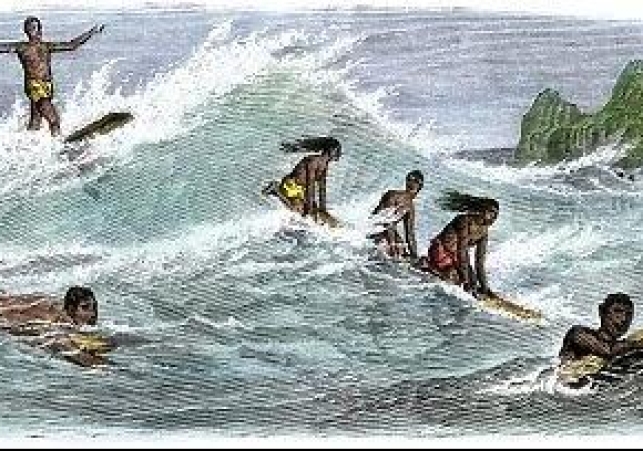The origins of surfing: Polynesian roots

Riding the Waves of History: The Polynesian Origins of Surfing
Surfing, with its exhilarating dance atop ocean waves, has captivated hearts and minds for centuries. While it's often associated with modern beach culture, the roots of surfing run deep into the ancient traditions of the Polynesian people. To understand the origins of this artful sport, we must embark on a journey through time and across the vast Pacific Ocean to explore the rich cultural tapestry of Polynesia.
The story of surfing begins in the cradle of Polynesian civilization, where the ocean served not only as a means of transportation but also as a source of sustenance, spirituality, and recreation. Polynesians, skilled navigators and seafarers, traversed the expansive oceanic expanse using canoes crafted with meticulous craftsmanship. These journeys were not merely pragmatic; they were imbued with cultural significance, as they connected distant islands and facilitated the exchange of knowledge, goods, and ideas.
Within this maritime culture, surfing emerged as a revered pastime, blending athleticism with spiritual reverence for the sea. Polynesians viewed the ocean as a living entity, teeming with mana, or spiritual power. Surfing was not merely a physical activity but a sacred ritual, a communion between the surfer and the divine forces of nature.
The earliest evidence of surfing dates back over a thousand years, with Polynesian oral traditions and archaeological findings providing glimpses into its ancient practice. Oral histories passed down through generations recount tales of legendary surfers riding majestic waves with grace and skill. Archaeological excavations have unearthed ancient wooden surfboards, known as "olo" or "alaia," crafted with intricate designs and adorned with spiritual symbols.
Surfing held a central place in Polynesian society, permeating all aspects of life. It was not confined to leisurely pursuits but played a role in rites of passage, social gatherings, and even warfare. Chiefs and warriors honed their surfing prowess as a display of strength and agility, while communal surfing sessions fostered camaraderie and social cohesion within island communities.
One of the most iconic symbols of Polynesian surfing culture is Waikiki Beach on the island of Oahu in Hawaii. Waikiki, which translates to "spouting waters," was revered by ancient Hawaiians as a sacred site where surfing rituals took place. It was here that the alii (chiefs) showcased their surfing skills, accompanied by chants and rituals invoking the blessings of the sea gods.
The arrival of European explorers in the Pacific in the 18th century marked a significant turning point in the history of surfing. With colonialism came cultural exchange, as Polynesian traditions collided with Western influences. Early accounts by European voyagers, such as Captain James Cook, documented the awe-inspiring sight of Polynesian surfers riding waves with unparalleled mastery.
Despite the impact of colonialism, surfing endured as a cherished cultural practice among Polynesian communities. However, the introduction of Western technology, such as metal tools and firearms, began to reshape traditional Polynesian society, leading to profound changes in lifestyle and cultural practices.
The 19th and 20th centuries witnessed a gradual decline in the prominence of surfing within Polynesian culture. Missionary efforts aimed to suppress indigenous customs deemed incompatible with Christian values, leading to the marginalization of traditional practices, including surfing. Moreover, the rapid spread of Westernization and industrialization further eroded the traditional way of life for many Polynesian communities.
However, despite these challenges, surfing persisted as a resilient cultural legacy, kept alive by dedicated practitioners and cultural revival movements. In the early 20th century, Hawaiian surfers like Duke Kahanamoku played a pivotal role in reintroducing surfing to the world stage, showcasing its beauty and athleticism to audiences far beyond the shores of Polynesia.
The mid-20th century witnessed a surfing renaissance, fueled by technological innovations and a burgeoning global interest in beach culture. The development of lightweight foam surfboards and advancements in wetsuit design revolutionized the sport, making it more accessible to enthusiasts around the world.
Today, surfing stands as a global phenomenon, embraced by millions of individuals who share a passion for riding the waves. From the shores of Hawaii to the beaches of California, from Australia's Gold Coast to Indonesia's pristine reefs, surfers unite in their love for the ocean and the exhilarating sensation of gliding across its azure waters.
Yet, amidst the modern-day spectacle of professional surfing competitions and surf tourism, it's essential to remember the ancient roots of this beloved sport. Polynesians, with their profound reverence for the sea and mastery of wave-riding techniques, laid the foundation upon which contemporary surfing culture thrives.
As we reflect on the origins of surfing, we are reminded of the enduring legacy of the Polynesian people and their profound connection to the ocean. Through their artful dance upon the waves, they beckon us to honor the wisdom of the past and to cherish the natural beauty of our planet's oceans for generations to come.
